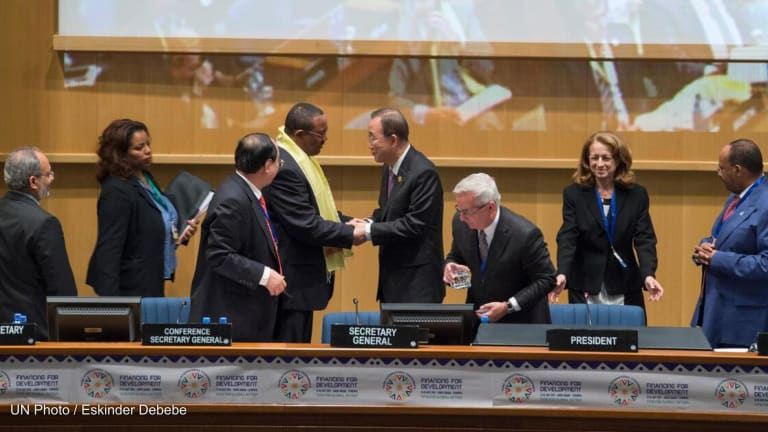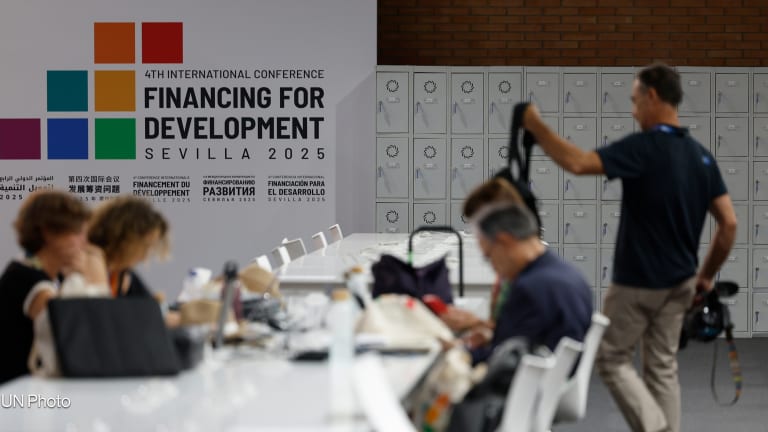
Last Wednesday, world leaders meeting in Addis Ababa, Ethiopia, agreed on a new framework on financing for development, which also addresses financing of the post-2015 development agenda, and its central principle that “no one must be left behind.” We work with one of the groups that have historically been left furthest behind in development: persons with disabilities. Now that the conference halls have fallen silent, and the ink has started to dry on the Addis Ababa Action Agenda, what difference will the new framework make to them?
Looking at the big picture, there’s a lot that could be strengthened in the Addis Ababa Action Agenda, which also fails to make time-bound commitments in support of people’s right to development in crucial areas, such as a global tax body. But within a not very promising big picture, we have been pleased to see a number of solid references to persons with disabilities and accessibility in the sections on social protection, employment, education, infrastructure, technology and data.
It’s crucial that those references are there. Persons with disabilities frequently miss out on the most basic services and opportunities. People like Mary, a 7-year-old in rural Uganda who dropped out of school because the teachers did not know how to accommodate her visual impairment. Or Pavi, a woman with disability in the slums of Dhaka, Bangladesh, who experienced discrimination in looking for work, and whose government disability allowance barely covers a single meal a day.
See more stories on disability and inclusive development:
► UN SDG process indicates exclusion is set to continue
► Australia steps up for disability-inclusive development
► Open the doors of education for Africa’s disabled students
► DfID to require partners to include disability, old age in proposals
Development finance should shift the existing power dynamics and reach people like Mary and Pavi. This is not only a human rights imperative; with 1 billion people with disabilities worldwide, it’s also vital for eradicating poverty, which is the overarching goal of both the financing for development and post-2015 frameworks. The International Labor Organization estimates countries may lose up to 7 percent of their gross domestic product if persons with disabilities do not have equal access to employment, and the World Bank says that it will be impossible to eradicate extreme poverty by 2030 unless development work focuses on disability.
So the explicit references to disability in the Addis Ababa Action Agenda are encouraging — but implementation will be key. Of course, successful implementation will be impossible without adequate resourcing — and that’s why we were calling for ambitious commitments from the conference last week, on issues such as a global tax body and aid.
Besides increasing total resourcing, we would look for three key actions from policymakers to implement a more disability-inclusive development finance framework:
1. Review policies and legislation to ensure they make services and infrastructure accessible to persons with disabilities. We have seen the difference that a favorable policy environment can make — in Tanzania, where the creation of a National Strategy on Inclusive Education opened the door for the government and civil society to work together to increase the number of children with disabilities attending school. Public policy also has an important role to play in regulating the private sector, and ensuring it creates opportunities for persons with disabilities, rather than further disadvantaging them. For example, public procurement policies that include inclusion and accessibility criteria can be a powerful tool to incentivise the production of accessible technologies and other products, as in the United States with its "Section 508" legislation.
2. Progressively publish disability-disaggregated data on public spending and administration, in accessible formats, to help track how government commitments on disability are put into practice. Gathering this data will require investment in national statistical capabilities; it will also require collaboration between the public, private and not-for-profit sectors to make the most of what data already exists, and to make new data accessible and transparent. But the more established field of gender budgeting has shown the power that transparent budget data can have — in Mexico, civil society organizations used budget data to highlight gaps in funding for women’s health, leading to an increase in resources for reproductive health care.
3. Ensure that persons with disabilities, including youth and women with disabilities, meaningfully participate in the design, implementation and monitoring of financial policies. Without such participation, it’s not going to be possible to redress the power imbalances that have left persons with disabilities behind in development. One of the most positive aspects of the financing for development and post-2015 processes has been the diversity and collaboration among civil society coalitions such as Beyond 2015 and Action/2015 — diversity that can be seen in the strong representation of disabled people’s organizations in these processes. Making space for the continued inclusive and accessible participation of persons with disabilities to work with their respective governments will be crucial in ensuring that the responsibilities set out in the Financing for Development framework are moved into practice, in line with the Convention of the Rights of Persons with Disabilities.
If properly resourced and implemented, the responsibilities on disability in the Addis Ababa Action Agenda could set a solid foundation for a world where persons with disabilities have fairer chances — and everybody benefits. Let’s just hope those good intentions don’t get left behind in the conference halls in Addis Ababa.
Missed major #Fin4Dev pledges and developments at the #FFD3 conference in Addis? Read the highlights from each day and reactions from civil society on major developments in our running blog.









